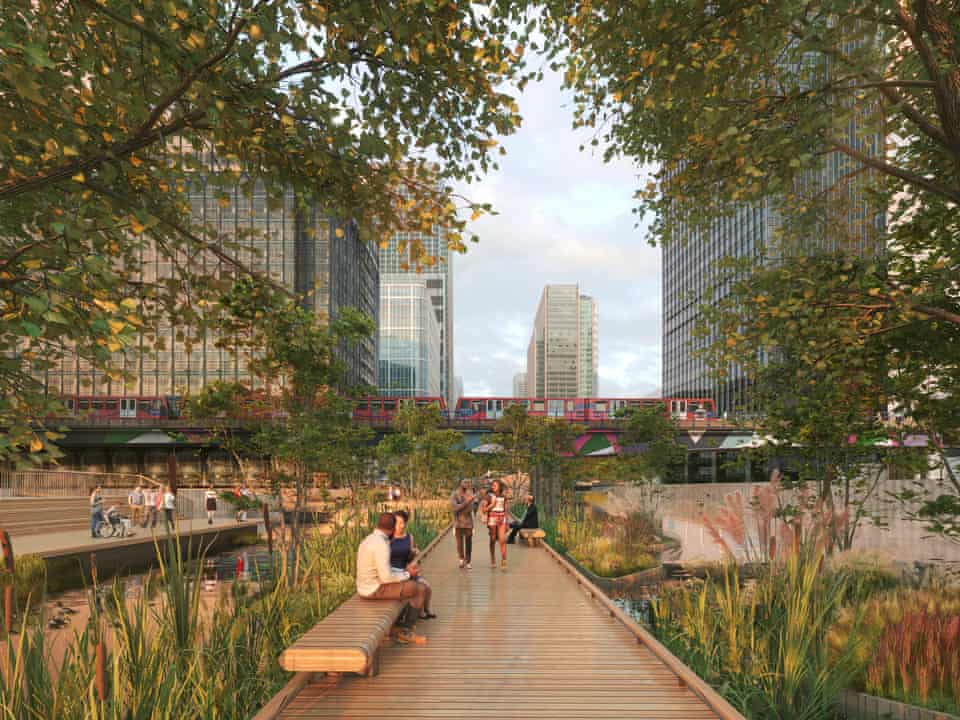This time last year, it was pretty quiet. “We had [less than] 100 customers a day when we opened a year ago.” Speaking on a hot June Thursday, he checks the till and finds that he has already done 600 orders.
In the depths of the Covid pandemic, the number of bankers and other workers commuting to their offices in Canary Wharf slowed to a trickle and the area turned into a ghost town. Since January, the numbers have gone up steadily as Covid restrictions lifted, says Shobi Khan, chief executive of Canary Wharf Group (CWG).

The property company has turned 52 hectares (128 acres) of wasteland in east London’s docklands into a new financial centre in recent decades, with the rival towers of the City, banking’s traditional home, visible in the distance. Canary Wharf now hosts banks such as JP Morgan, Citigroup, Barclays, HSBC and Société Générale as well as the accounting firm KPMG.
Like many firms, KPMG has moved to hybrid working, with almost half of its 16,000 UK staff now visiting the office at least one day a week.
As a result of the shift in commuting patterns, Canary Wharf is still much quieter on Mondays and Fridays, but Khan says the picture is improving. “Every week, people are coming back in earnest – depending on the companies, some are at 70%, some companies are at 50% but it’s continually growing.”
Transport for London (TfL) says trips to the docklands financial hub are at about 70% of pre-pandemic levels, similar to the rest of the tube network. At Canary Wharf station, excluding the new Elizabeth line, TfL has typically recorded 305,000 exits a week compared with 420,000 to 450,000 in May 2019. Weekends are back to normal levels.
A recent Centre for Cities report found that home working has left bars, cafes and restaurants in UK city centres up to 25% worse off than in 2019, with sales of food and drinks in central London during the working week down 20%.
Valentine Quinio, senior analyst at the thinktank, says: “It’s been nearly six months since we’ve all been advised to travel to the office again, but still commutes aren’t as busy as they used to be. High rates of home working are a threat for the high street, and in particular for the hospitality sector which, before Covid, heavily relied on office workers coming in. In places like Canary Wharf, the issue is perhaps even more acute than in central London, where retailers can also rely on weekday shoppers and tourists.”
However, she thinks Canary Wharf will survive, noting that in high-skilled jobs there are big benefits to be had from meeting face-to-face, although it may have to repurpose some office and commercial space.
At nearby London City airport, which was bought by a Canadian consortium in 2016 for an eyewatering £2bn, passenger numbers had recovered to 1 million by May this year and are forecast to hit almost 3 million over 2022.
However, traveller numbers are not expected to get back to the 5.1 million seen in 2019 until 2024 at the earliest. To win back passengers the airport is adding new routes, including Thessaloniki, Santorini and Skiathos in Greece, and Split in Croatia. Direct flights to Barcelona, Guernsey and Jersey will also restart.
Pergola on the Wharf, a restaurant near KPMG, opened last July and has been surprised by the strength of bookings, especially at weekends when it hosts late-night shindigs. “People travel to Canary Wharf to party because perhaps they don’t want to go to the West End,” says Anthony Knight, the restaurant’s sales and marketing director.
But it’s also a “grab a beer after work” venue attracting bankers and other office workers. “They are there in droves on a Wednesday evening. Thursdays are definitely the new Friday across London,” he says.
In autumn, the European Bank for Reconstruction and Development is moving its London headquarters from the City to a 24-storey tower in Canary Wharf, which will house 2,500 staff. So too is Genomics England, which analyses sequenced genomes for the NHS to help find the cause of diseases.
Khan also hopes to build a new life sciences cluster to rival those in Oxford and Cambridge. Canary Wharf is already home to the UK health regulator, the Medicines and Healthcare products Regulatory Agency. CWG has teamed up with the specialist developer Kadans Science Partner to build a 750,000 sq ft commercial laboratory building, the largest in Europe, and hopes to attract smaller biotech firms.
Khan reiterates CWG’s mantra of getting people to “live, work and play” in the area. The first residents moved into high-rise apartment blocks on Wood Wharf in 2020, just across the water from the gleaming banking towers.

CWG is building 3,600 homes on the 9-hectare (23-acre) Wood Wharf site, where timber was stored in the 19th century, with a new primary school opening in September. There are also plans for a private school. More than half of the 2,000 homes completed so far are for rent, including some at discounted market rates.
In July, the company hosts its first art, music, comedy and theatre festival over four days, and many events are free. It hopes that Grandmaster Flash, the Barbadian-American DJ and rapper, Jocelyn Brown, the American R&B and dance singer, and the Ronnie Scotts inhouse jazz band will draw the crowds.
Retrieved from :https://www.theguardian.com/business/2022/jul/01/back-in-earnest-canary-wharfs-post-covid-comeback-almost-in-full-swing (1 July, 2022)
The information provided on this website is for reference only. C21 International shall not be liable for any errors, omissions, misstatements, or misrepresentations (express or implied), concerning any Information, and shall not have or accept any liability, obligation, or responsibility whatsoever for any loss, destruction, or damage (including without limitation consequential loss, destruction or damage) howsoever arising from or in respect of using, misusing, inability to use, or relying on the Information.

